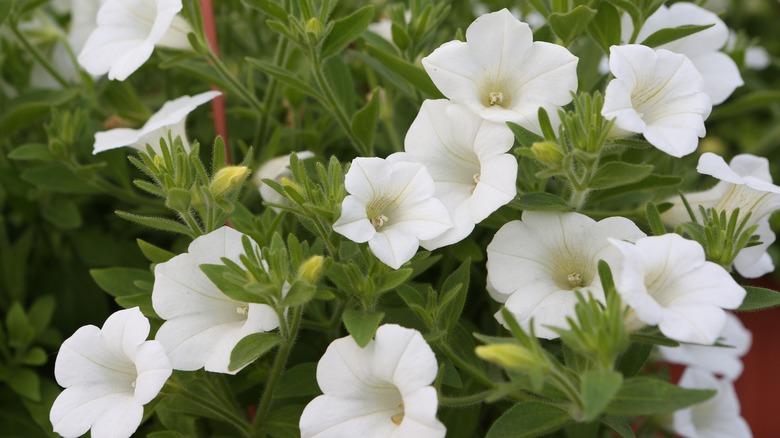The Beautiful Petunia Look-Alike That's Really An Invasive Weed
Each June, bindweed plants (Calystegia sepium) bloom delicate, light pink and white trumpet-shaped flowers that can be easily mistaken for petunias, a familiar favorite that has a very similar appearance. Petunia is a beloved and versatile flowering plant that has long been a staple for many gardeners. While bindweed has similar pretty, dainty flowers, it isn't a friend to your garden or yard. It's actually an aggressive and invasive species that, unlike the tender petunia, is quite hardy and is able to withstand poor soil, drought, and even being repeatedly mowed down.
Adaptable and hardy, bindweed pops up throughout most of the United States besides some areas in the South. You want to keep it out of your garden because, if left to grow, it will outcompete nearby plants as it spreads several feet across the ground. It will also wind up any structure or plant in its path, strangling native species and destroying any potential for stunning flower gardens or thriving vegetables. It has also been known to ruin flowerbeds and crop fields. Unfortunately, it's also super difficult to eradicate because of its deep rhizomes. Gardeners who hope to protect their plants from being overtaken should control its spread as soon as they identify it, but removing the plant won't be easy and certain steps should be followed to prevent constant regrowth. Discover how to differentiate this harmful plant from petunias and how to remove it from your yard.
How to identify bindweed
Luckily, there are a few ways to differentiate between bindweed and petunias. The first way is to take a look at their leaves. You'll know you've found bindweed because the leaves are arrow-shaped and grow alternately on a long stem. In comparison, petunias leaves are typically oval-shaped. Further, bindweed is a vine that can extend up to 6 feet in length, while petunias typically grow upright and only reach about 6 to 18 inches tall. However, keep in mind that there are also trailing petunias which can reach 4 feet in length.
Just like petunias, the summer-blooming flowers on the invasive vine are funnel-shaped, delicate, and soft, which can make telling them apart difficult. However, those of the bindweed only appear in two colors, white and pink, whereas petunias come in a wide variety of colors and patterns. A faint white or yellow tinge can be seen in the center of bindweed blooms as well, which may be a helpful indicator that you've identified this harmful plant successfully.
How to remove bindweed
Gardeners working to get rid of these weeds in their garden need to employ repeated, targeted methods to have any hope of controlling bindweed. The taproots are vast and persistent, as they can grow rhizomes that can extend 9 feet deep with more extensive roots in the first 2 feet of soil. Therefore, simply mowing over the plant will not work. Because the plant reproduces through both seeds and root fragments, full removal is necessary to prevent regrowth. Unfortunately, it could take years of seasonally digging back growth and roots to totally eliminate established bindweed. That means you may need to dig out the soil and regrowing roots a few times throughout your gardening season, as well as continue the process in the following years.
Regrowth may also be controlled by planting plants that produce shade over the weed, since it doesn't tolerate the absence of sunlight. Gardeners also use dense plants or grasses that can smother bindweed. If the weed isn't close to your other plants, repeat spraying of glyphosate herbicides when the plant is flowering will help with removal. These herbicides are absorbed into the foliage and eventually soak into the plant to kill off the root system. Spray leaves without cutting the plant back since it may take several applications before the chemical penetrates enough to be effective.


